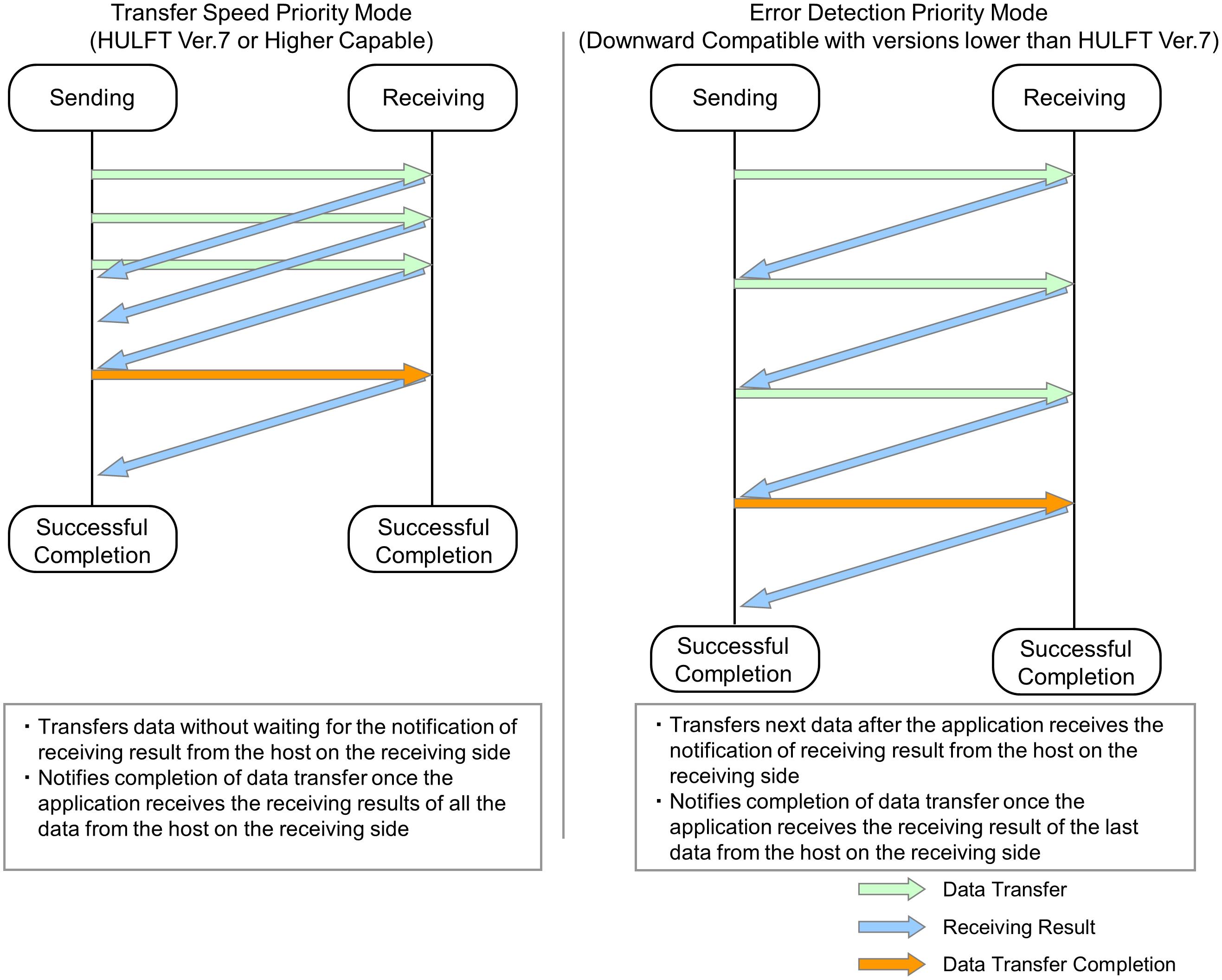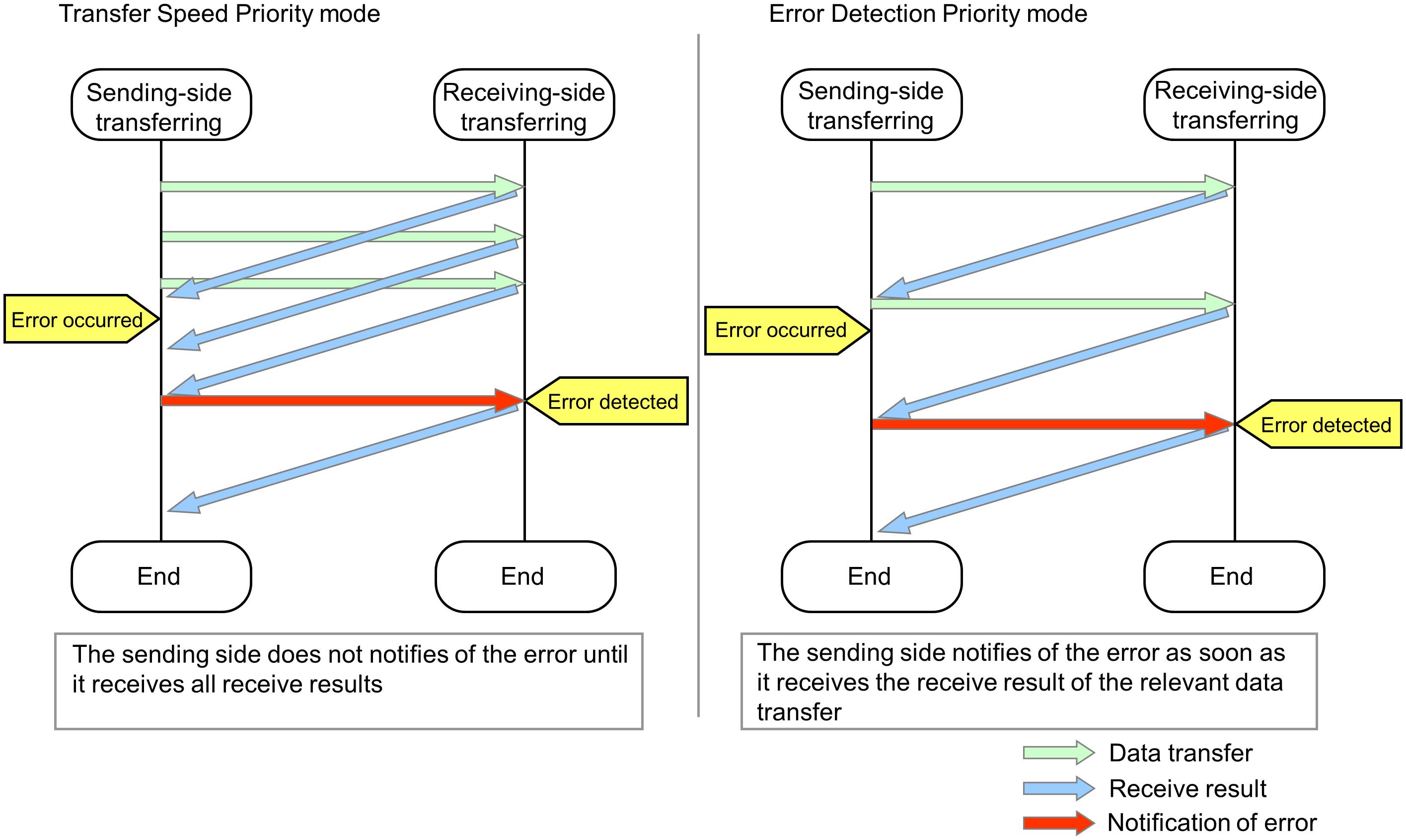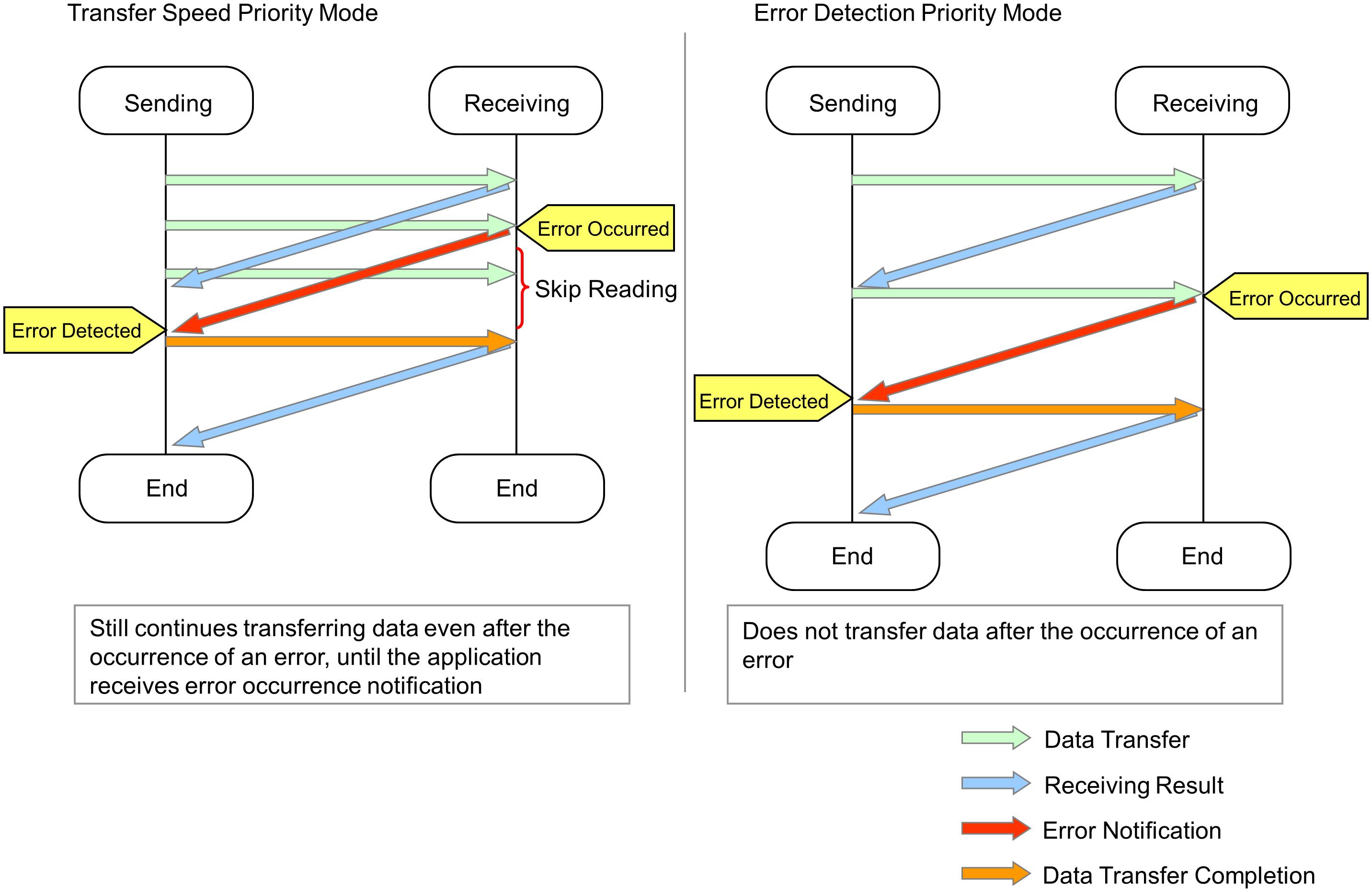Data Transfer Method (Framed Message Transfer)
HULFT Ver.7 or higher allows you to select Transfer Speed Priority mode or Error Detection Priority mode. In Transfer Speed Priority mode, HULFT transfers data without waiting for the receive result notification from the remote host.
In Transfer Speed Priority mode, data transfer speed improves using the high-speed network environment and large data transfers. The Error Detection Priority Mode, which is the conventional transfer method of HULFT Ver.6 or lower, waits for the confirmation of block transfer from remote host and then proceeds to the transfer of next block. Therefore, the transfer speed in the Error Detection Priority Mode is slower than the Transfer Speed Priority Mode, yet the former performs error detection swiftly.
(1) Transfer Speed Priority Mode and Error Detection Priority Mode
Shown below is an illustration of the difference between the Transfer Speed Priority Mode and the Error Detection Priority Mode.

Figure 2.25 Difference between Transfer Speed Priority mode and Error Detection Priority mode
To set data transfer method, both sending host and receiving host should use HULFT Ver.7 or higher. In addition, HUB-Server to be routed through should be Ver.2.2 or higher, if these hosts use HULFT-HUB. If you use HULFT of lower version (namely, HULFT Ver.6 or lower), data transfer is performed in the Error Detection Priority mode.
Further, to use Transfer Speed Priority mode, the mode needs to be enabled on both the sending-side and receiving-side hosts. If either of the hosts is in Error Detection Priority mode, data is transferred in Error Detection Priority mode.
(2) Setting of Framed Message Transfer Type
Data transfer method can be set by selecting the Framed Message Transfer Type (PROCTRANSTYPE) in the System Environment Settings. There are four options in the Framed Message Transfer Type:
- N (Error Detection Priority Mode)
-
This option transfers data in the Error Detection Priority Mode, at the time both of sending and receiving
- S (Send Speed Priority Mode)
-
This option transfers data in the Transfer Speed Priority Mode for sending. This option transfers data in the Error Detection Priority Mode for receiving.
- R (Receive Speed Priority Mode)
-
This option transfers data in the Transfer Speed Priority Mode for receiving. This option transfers data in the Error Detection Priority Mode for sending.
- A (Send and Receive Speed Priority Mode)
-
This option transfers data in the Transfer Speed Priority Mode at the time both of sending and receiving.
Combination of the Framed Message Transfer Types of the sending side and the receiving side determines which data transfer method to be performed. See the following table:
|
Sending Side |
Host on Receiving Side |
|||
|---|---|---|---|---|
|
N |
S |
R |
A |
|
|
N |
|
|
|
|
|
S |
|
|
✔ |
✔ |
|
R |
|
|
|
|
|
A |
|
|
✔ |
✔ |
|
✔ |
: |
Operation in the Transfer Speed Priority Mode |
|
Blank |
: |
Operation in the Error Detection Priority Mode |
Framed Message Transfer Type should be set based upon user's circumstances of sending and receiving. The figure below illustrates examples of settings for the Framed Message Type based upon user's circumstances:

Figure 2.26 Examples of settings for framed message transfer types
(3) Timing of Error Detection
The timing of error detection differs depending on the specified data transfer method. This section explains the difference in the timing of error detection between the Error Detection Priority Mode and the Transfer Speed Priority Mode.
Where an error occurs on the sending side

Figure 2.27 When a sending error is detected in Transfer Speed Priority mode and Error Detection Priority mode
Where an error occurs on the receiving side

Figure 2.28 When a receiving error is detected in Transfer Speed Priority mode and Error Detection Priority mode
In the Transfer Speed Priority Mode, utilization of resources varies more widely than the Error Detection Priority Mode, which may cause delay in the error detection timing of transfer and the acknowledgement timing of cancellation.
(4) Points to be Noted
If there is no improvement in transfer speed despite the specification of the Transfer Speed Priority Mode, following factors may be considered. Solve your problem by consulting with following information:
Partner host specifies the Error Detection Priority Mode
Set the Framed Message Transfer Type to any one of the Transfer Speed Priority Mode options both for sending and receiving hosts.
Partner host uses the product version that does not support the Transfer Speed Priority Mode
Upgrade HULFT to the product version that supports the Transfer Speed Priority Mode both for sending and receiving hosts.
Insufficient network band
The Transfer Speed Priority Mode requires more network traffic than the Error Detection Priority Mode. Insufficient network band causes mild effect of the Transfer Speed Priority Mode.
Small socket buffer size in a sending host and in a receiving host
Modify the setting of the following fields of the System Environment Settings on a sending host and a receiving host:
-
Socket Buffer Size for Data Sending (SNDSOCKSIZE)
-
Socket Buffer Size for Data Receiving (RCVSOCKSIZE)
Usually, the greater Transfer Block Size is, the faster the transfer speed becomes, yet optimum value varies depending on network environment.
The Transfer Block Size on the sending side is not the optimum value of network
Modify the setting of Transfer Block Size in the Send Management Information on HULFT. Usually, the greater Transfer Block Size is, the faster the transfer speed becomes, yet optimum value varies depending on network environment.